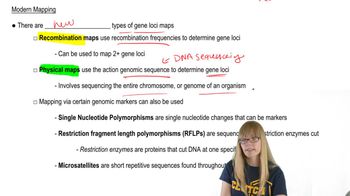Dideoxy nucleotides (ddNTPs) are used in Sanger sequencing because they have what function?
Table of contents
- 1. Introduction to Genetics51m
- 2. Mendel's Laws of Inheritance3h 37m
- 3. Extensions to Mendelian Inheritance2h 41m
- 4. Genetic Mapping and Linkage2h 28m
- 5. Genetics of Bacteria and Viruses1h 21m
- 6. Chromosomal Variation1h 48m
- 7. DNA and Chromosome Structure56m
- 8. DNA Replication1h 10m
- 9. Mitosis and Meiosis1h 34m
- 10. Transcription1h 0m
- 11. Translation58m
- 12. Gene Regulation in Prokaryotes1h 19m
- 13. Gene Regulation in Eukaryotes44m
- 14. Genetic Control of Development44m
- 15. Genomes and Genomics1h 50m
- 16. Transposable Elements47m
- 17. Mutation, Repair, and Recombination1h 6m
- 18. Molecular Genetic Tools19m
- 19. Cancer Genetics29m
- 20. Quantitative Genetics1h 26m
- 21. Population Genetics50m
- 22. Evolutionary Genetics29m
15. Genomes and Genomics
Sequencing the Genome
Problem 1a
Textbook Question
How do we know which contigs are part of the same chromosome?
 Verified step by step guidance
Verified step by step guidance1
Understand that contigs are continuous sequences of DNA assembled from overlapping reads, but they do not inherently indicate their position on chromosomes.
Use paired-end or mate-pair sequencing data, where pairs of reads are known to be a certain distance apart; if pairs map to different contigs, this suggests those contigs are physically close on the same chromosome.
Apply genetic linkage information or physical mapping techniques such as fluorescence in situ hybridization (FISH) to associate contigs with specific chromosomes.
Utilize long-range sequencing technologies or scaffolding methods that link contigs based on known distances or chromatin conformation capture data (e.g., Hi-C) to group contigs into chromosome-scale assemblies.
Integrate all these data sources to build scaffolds and assign contigs to chromosomes by analyzing consistent linkage, proximity, and mapping evidence.
 Verified video answer for a similar problem:
Verified video answer for a similar problem:This video solution was recommended by our tutors as helpful for the problem above
Video duration:
1mPlay a video:
Was this helpful?
Key Concepts
Here are the essential concepts you must grasp in order to answer the question correctly.
Contigs and Genome Assembly
Contigs are continuous sequences of DNA assembled from overlapping short reads during genome sequencing. Understanding how contigs are formed helps in piecing together the genome, but contigs alone do not indicate their chromosomal origin without further analysis.
Recommended video:
Guided course

Genomics Overview
Physical and Genetic Mapping
Physical mapping uses techniques like fluorescence in situ hybridization (FISH) or optical mapping to locate contigs on chromosomes, while genetic mapping relies on recombination frequencies between markers. Both methods help assign contigs to specific chromosomes by providing positional information.
Recommended video:
Guided course

Modern Mapping
Paired-End and Mate-Pair Sequencing
Paired-end and mate-pair sequencing generate reads from both ends of DNA fragments of known size, linking contigs that are physically close on the same chromosome. This linkage information is crucial for ordering contigs and determining their chromosomal association.
Recommended video:
Guided course

Sequencing Difficulties
Related Videos
Related Practice
Multiple Choice
693
views
1
rank


